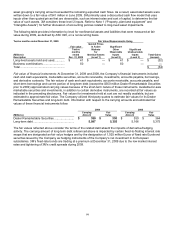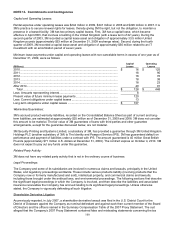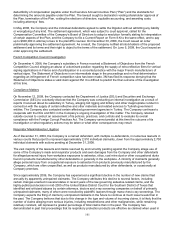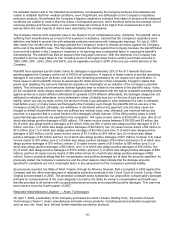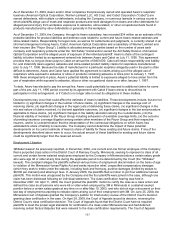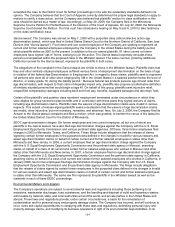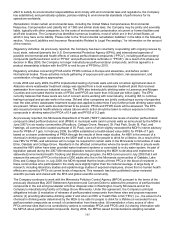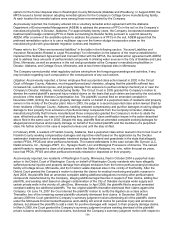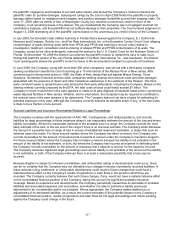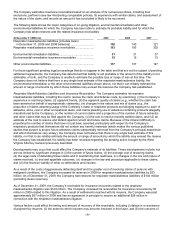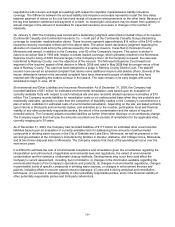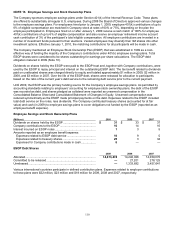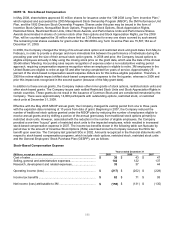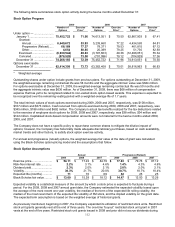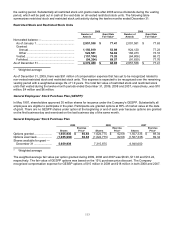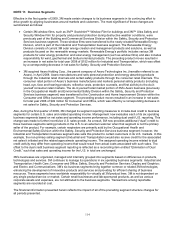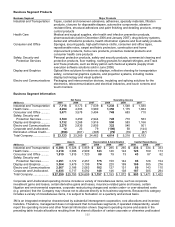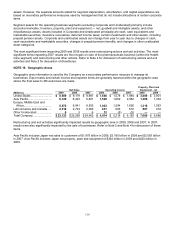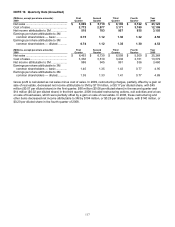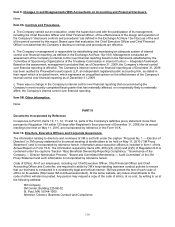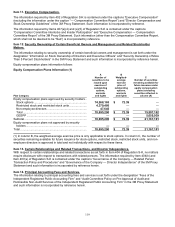3M 2009 Annual Report Download - page 115
Download and view the complete annual report
Please find page 115 of the 2009 3M annual report below. You can navigate through the pages in the report by either clicking on the pages listed below, or by using the keyword search tool below to find specific information within the annual report. 109
negotiations with insurers and legal proceedings with respect to respirator mask/asbestos liability insurance
coverage. The difference between the accrued liability and insurance receivable represents in part the time delay
between payment of claims on the one hand and receipt of insurance reimbursements on the other hand. Because of
the lag time between settlement and payment of a claim, no meaningful conclusions may be drawn from quarterly or
annual changes in the amount of receivables for expected insurance recoveries or changes in the number of
claimants.
On January 5, 2007 the Company was served with a declaratory judgment action filed on behalf of two of its insurers
(Continental Casualty and Continental Insurance Co. — both part of the Continental Casualty Group) disclaiming
coverage for respirator mask/asbestos claims. These insurers represent approximately $14 million of the $143 million
insurance recovery receivable referenced in the above table. The action seeks declaratory judgment regarding the
allocation of covered costs among the policies issued by the various insurers. It was filed in Hennepin County,
Minnesota and named, in addition to the Company, over 60 of the Company’s insurers. This action is similar in
nature to an action filed in 1994 with respect to breast implant coverage, which ultimately resulted in the Minnesota
Supreme Court’s ruling of 2003 that was largely in the Company’s favor. At the Company’s request, the case was
transferred to Ramsey County, over the objections of the insurers. The Minnesota Supreme Court heard oral
argument of the insurers’ appeal of that decision in March 2008 and ruled in May 2008 that the proper venue of that
case is Ramsey County. The case has been assigned to a judge in Ramsey County District Court. The plaintiff
insurers have served an amended complaint that names some additional insurers and deletes others. Several of the
insurer defendants named in the amended complaint have been dismissed because of settlements they have
reached with 3M regarding the matters at issue in the lawsuit. The case remains in its early stages with a trial
scheduled to begin in June, 2012.
Environmental and Other Liabilities and Insurance Receivables: As of December 31, 2009, the Company had
recorded liabilities of $31 million for estimated environmental remediation costs based upon an evaluation of
currently available facts with respect to each individual site and also recorded related insurance receivables of $15
million. The Company records liabilities for remediation costs on an undiscounted basis when they are probable and
reasonably estimable, generally no later than the completion of feasibility studies or the Company’s commitment to a
plan of action. Liabilities for estimated costs of environmental remediation, depending on the site, are based primarily
upon internal or third-party environmental studies, and estimates as to the number, participation level and financial
viability of any other potentially responsible parties, the extent of the contamination and the nature of required
remedial actions. The Company adjusts recorded liabilities as further information develops or circumstances change.
The Company expects that it will pay the amounts recorded over the periods of remediation for the applicable sites,
currently ranging up to 30 years.
As of December 31, 2009, the Company had recorded liabilities of $117 million for estimated other environmental
liabilities based upon an evaluation of currently available facts for addressing trace amounts of perfluorinated
compounds in drinking water sources in the City of Oakdale and Lake Elmo, Minnesota, as well as presence in the
soil and groundwater at the Company’s manufacturing facilities in Decatur, Alabama, and Cottage Grove, Minnesota,
and at two former disposal sites in Minnesota. The Company expects that most of the spending will occur over the
next seven years.
It is difficult to estimate the cost of environmental compliance and remediation given the uncertainties regarding the
interpretation and enforcement of applicable environmental laws and regulations, the extent of environmental
contamination and the existence of alternate cleanup methods. Developments may occur that could affect the
Company’s current assessment, including, but not limited to: (i) changes in the information available regarding the
environmental impact of the Company’s operations and products; (ii) changes in environmental regulations, changes
in permissible levels of specific compounds in drinking water sources, or changes in enforcement theories and
policies, including efforts to recover natural resource damages; (iii) new and evolving analytical and remediation
techniques; (iv) success in allocating liability to other potentially responsible parties; and (v) the financial viability of
other potentially responsible parties and third-party indemnitors.


